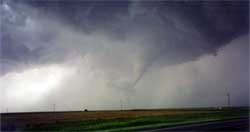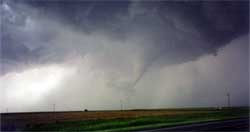 Lincoln resident turning big storms into career, hobby
Lincoln resident turning big storms into career, hobby
NARRAGANSETT, R.I. – December 30, 2008 – As a child, Richard Yablonsky took an unusually serious interest in astronomy, meteorology, and natural disasters, consuming every bit of information he could about the subjects and even convincing his parents to take family vacations to places where he could learn more.
His interest hasn’t waned. As a doctoral student at the University of Rhode Island, Yablonsky is making important discoveries about hurricane intensity. And during his free time, he travels to the Midwest to pursue his favorite hobby – tornado chasing.
A native of Durham, N.C. who now lives in Lincoln, R.I., Yablonsky enrolled at URI’s Graduate School of Oceanography in 2004 to study with Isaac Ginis, one of the world’s leading experts on the role the ocean plays in intensifying hurricanes.
“My research deals with subsurface ocean temperature features and how those features can feed back to the hurricane’s intensity,” explained the Lincoln, R.I. resident. “Until recently, it was assumed that only the sea surface temperature ahead of a hurricane is important for predicting the future intensity change of the storm. Meteorologists were reluctant to look below the surface. But because hurricanes mix the ocean, the subsurface temperature is important, too.”
Yablonsky is examining the effect of warm ocean eddies – ring-shaped ocean currents with warmer water inside the ring than outside it — on hurricane intensity. He said that when a warm ocean eddy is located on the left side of a storm track, the eddy pushes cold water from the hurricane’s wake further behind the storm, allowing the storm to continually pass over warm water and subsequently intensify. If the eddy is on the right side of a storm track, however, cold water from the hurricane’s wake is pushed ahead of the storm, limiting the storm’s intensity.
“The part about a warm ocean eddy on the right side of the storm track limiting storm intensity is new and exciting because it was totally unexpected when I began looking at it,” Yablonsky said.
Regardless of the status of his research or anything else happening in his life, whenever Memorial Day comes around, Yablonsky and his wife, Tracy McCormick, drop everything and fly to Kansas City to pursue their passion for chasing tornadoes.
“Ever since high school, I’ve been fascinated by tornadoes,” Yablonsky said. “My parents got me tornado videos, we went to see the movie Twister, and I always dreamed of tornado chasing. During a summer internship in 2000 in Norman, Okla., where I met my wife, we did our first storm chasing, but we didn’t see much.”
A week-long storm chasing experience in 2002 ignited his passion, and since 2005, Yablonsky, McCormick — who works for the National Weather Service in Taunton, Mass. — and a few of their friends have chased storms for a week or two each May, a month that he calls “the climatological tornado peak in the Midwest.”
“We fly into Kansas City, rent a car, connect our laptops to the Internet, and make a series of forecasts,” he explained. “We look at computer model data to find our target location, and then we start looking at real-time weather data and radar. We just go wherever the storms are most likely to be.”
Although the tornado chasers didn’t find any tornadoes in 2005 or 2006, they hit the jackpot in 2008, seeing two tornadoes on their first day, including a half-mile wide “wedge tornado” near Quinter, Kansas that Yablonsky described as “a monster, by far the largest and most powerful tornado we’ve seen.”
Their scariest moment occurred on May 26 when they concluded that meteorological conditions weren’t favorable for tornadoes and so they weren’t paying as much attention as they should have been.
“A rotating wall cloud and possible funnel cloud ended up over our heads, and we had to take cover in the back kitchen of a McDonald’s in Pratt, Kansas as tornado sirens sounded in the town. The manager of the McDonald’s huddled everyone in back, and we waited it out. A tornado was reported a couple of miles from us, so that circulation over our heads probably touched down nearby.”
While Yablonsky said that experience scared him enough to want to take a couple of years off from tornado chasing, his wife doesn’t want to stop.
“I have a love-hate relationship with tornadoes,” he said. “I’m equally excited by them as I am afraid of them. It’s a rush, it’s a thrill, and it’s a bit of an adrenaline thing.”
But tornado chasing isn’t just a hobby to Yablonsky and McCormick.
“When appropriate, we call in to the National Weather Service to report what we see and to help them issue or verify warnings. In that way, we’re contributing to the safety of the residents threatened by tornadoes. And every time we come back from a storm chase, I know I’ve learned a ton more than I could learn in books and journal articles alone.
“But mostly, we’re out there for the fun of it,” he said.
Photo by Tracy McCormick

